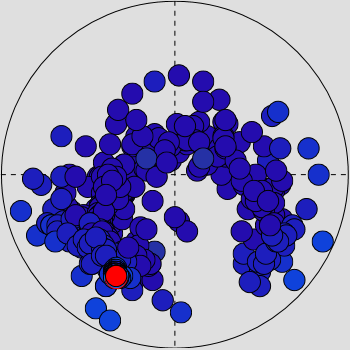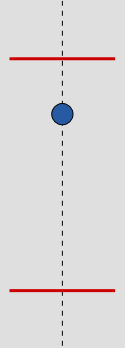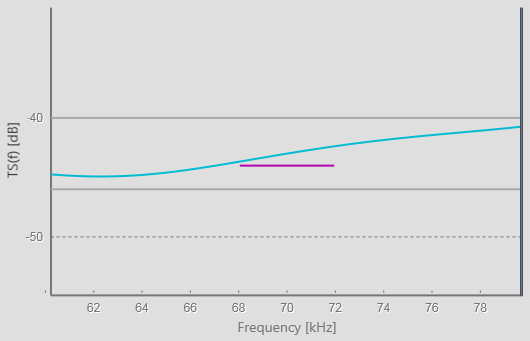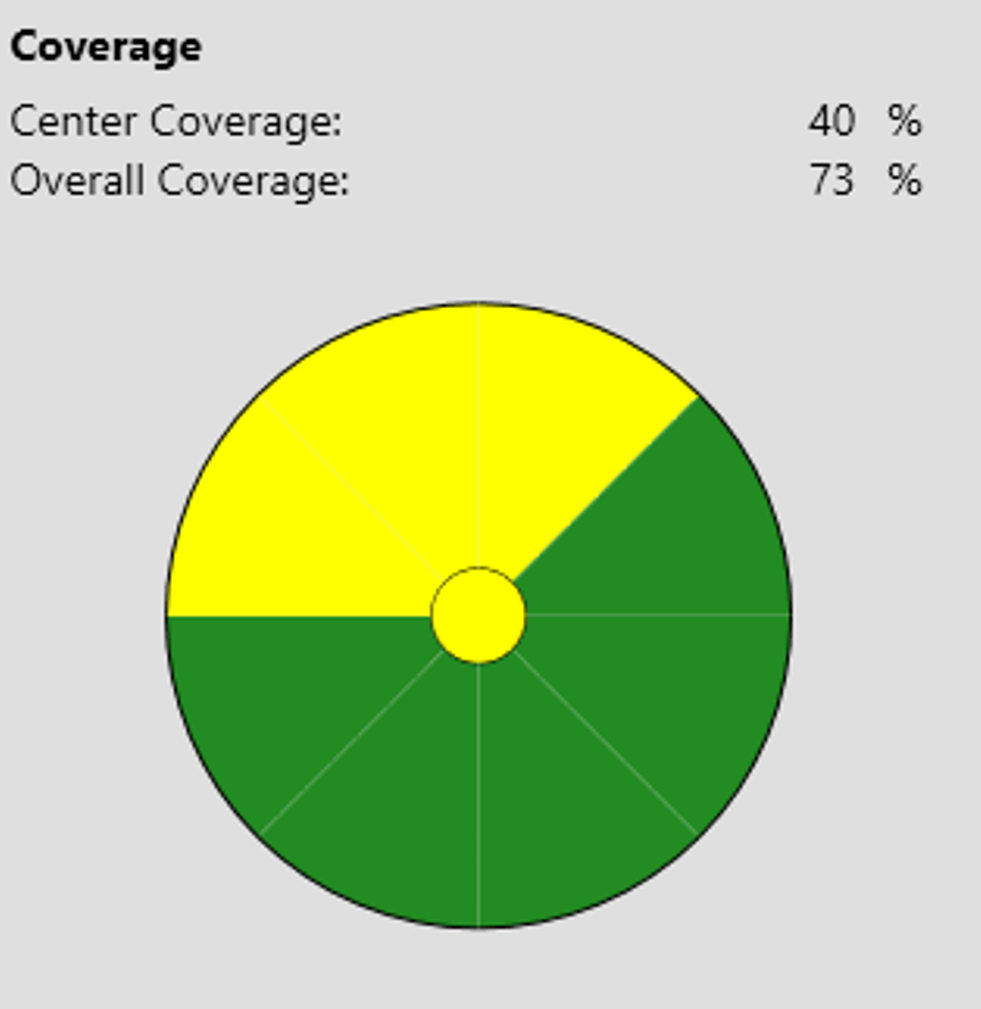Calibration Wizard dialog box #4 (Import Data)
The fourth page in the Calibration Wizard allows you to import the echo data into the calibration process. You can make changes to the single target detection, and
add a brief description, but you are not permitted to do anything with the echo data.
Prerequisites
The Calibration Wizard dialog box can only be opened within the calibration process. In order to start the calibration wizard, the EK80 must be in either Normal or Replay mode.
How to open
To open the Calibration Wizard, place the EK80 in either Normal or Replay mode, and select Calibration on the Setup menu.

In the first Calibration Wizard dialog box, select New calibration from raw data (Real time or Replay). This opens page 2. In the second page of the Calibration Wizard dialog box, select the channel to calibrate and select Next at the bottom of the page. This opens page 3. In the third page of the Calibration Wizard dialog box, select the sphere to calibrate for and select Next at the bottom of the page.This opens page 4.
Description
The fourth page of the Calibration Wizard dialog box is divided into three fields.
Tip
To change the size of the individual field, click and drag the field borders. You can also increase the size of the dialog box. To make the dialog box cover the entire screen, double-click the title bar.
| • | Target Position field The left side of the Target Position field shows all the individual echoes that are imported into the calibration program. All echoes are placed inside a circle to reflect their locations in the beam. The right side of the field shows the calibration layer that is automatically created once the calibration starts.
|
| • | Frequency/Target Strength field The Frequency/Target Strength field shows a curve reflecting the target strength of the sphere for individual frequencies. This is the same curve as you can see in the Calibration Wizard dialog box page four, but with a few additional features.
|
| • | Numerical field The Numerical field provides several tabbed pages. The General page shows the common data and parameters for the system. Transceiver parameters common to all beams The Channel Data page displays numerical parameters related to the transceiver channel that was used to record the echo data. The TS Data page displays the numerical parameters related to each individual echo.
|
Target Position field

The left side of the Target Position field shows all the individual echoes that are imported into the calibration program. All echoes are placed inside a circle to reflect their locations in the beam. The echoes are compensated for their positions within the beam, so that echoes from the outer edge appear with the same echo
strength as those in the middle of the beam.
| • | When you calibrate for CW (continuous wave), the outer border of the beam model signifies a 3 dB loss. |
| • | In FM calibrations, additional circles (dotted lines) are added to signify the upper and middle frequencies. |
If you select a single echo on the TS Data list, the relevant echo is shown with a red colour in the Target Position field. You will not be able to do anything with the echoes at this time. The TS Data page only provides the list. However, on the fourth page of the Calibration Wizard you can remove the echoes that you do not wish to be included in the calibration.

The right side of the field shows the calibration layer that is automatically created once the calibration starts. You can see how each individual echo is received within the calibration layer. This calibration layer is automatically established
when the Calibration Wizard is started. Its purpose is to remove echoes over and below the calibration target(sphere). You can easily see the layer in
the echogram, as it is identified with two red horizontal lines. If you see that many echoes are in fact falling outside the layer, you can adjust its size by clicking on the red lines and
moving them up or down. The red lines in the echogram will be moved accordingly, but the lines in the Target Position field will assume their original position once you release the mouse button.
Frequency/Target Strength field
The Frequency/Target Strength field shows a curve reflecting the target strength of the sphere for individual frequencies. The field is located below the Target Position field.

The Frequency/Target Strength field shows the relationship between the frequency and the target strength for the sphere in current use.
| • | The blue line represents the relationship curve. |
| • | The two grey lines reflect the limits defined by the TS Deviation setting on the General page in the Numerical field. Echoes over and below these lines will not be imported into the calibration process. |
| • | The purple line reflects the bandwidth of the current "ping". The bandwidth is inverse proportional with the pulse length. |
Numerical field
This field is located on the right side of the Calibration Wizard dialog box. The Numerical field provides several tabbed pages.
| • | The General page shows the common data and parameters for the system. Calibration: System information Transceiver parameters common to all beams |
| • | The Channel Data page displays numerical parameters related to the transceiver channel that was used to record the echo data. When you calibrate in FM, the page also offers curves to monitor the gain, the beamwidth and the beam offset as a function of the operating frequency. |
| • | The TS Data page displays the numerical parameters related to each individual echo. If you select a single echo on the TS Data list, the relevant echo is shown with a red colour in the Target Position field. You will not be able to do anything with the echoes at this time. The TS Data page only provides the list. However, on the fourth page of the Calibration Wizard you can remove the echoes that you do not wish to be included in the calibration.
|
Coverage

During the data import, monitor the coverage.
The General page in the Numerical field presents both numerical and a visual presentation of the coverage. The area covered by the transducer beam is shown as a circle with "slices" for each transducer sector. A split-beam transducer has three or four sectors. The circular cross-section is split into several slices.
To successfully calibrate the EK80 you need to place a number of target detections in each sector. The echoes must be distributed within the entire beam cross-section. In order to do this, the target sphere must be physically moved inside the beam during the calibration process. If the sphere location is constant, you will be rewarded with many echoes, but all will be inside the same sector. The number of sphere detections should be approximately the same for each sector, and in total not more than 100 for the whole
beam cross-section.
The coverage circle uses colour coding to show you the current coverage.
| • | Red colour means that you do not have enough echoes in the relevant sector (0 to 25%). |
| • | Yellow colour means that you have many echoes in the relevant sector, but not enough (25 to 50%). |
| • | Green colour means that you have enough echoes in the relevant sector for a successful calibration (better than 50% coverage). |
A small circle in the middle represents the coverage in the centre of the beam. It uses the same colour coding.
The numerical values for the center and overall coverage are shown over the coverage circle.
Calibration layer
When the calibration process is started, a dedicated layer is automatically created. If a strong and easily detected echo from the calibration sphere is shown in the echogram, the layer will position its borders
over and under the target.
You must lower the sphere to a known depth. If you manage to keep the sphere at this depth when is moved in the beam during the calibration, you can adjust the calibration layer to make a
smaller "depth window". This removes unwanted echoes.
During the calibration process, the calibration layer must be monitored and adjusted to compensate for the target’s depth
changes. These depth changes are easy to see in the echogram, or on the right side of the Target Position field. The depth limits of the calibration layer can be adjusted in three different ways:
| • | You can select a red line in the echogram, and drag it up or down. |
| • | You can select a red line on the right side of the Target Position field, and drag it up or down. |
| • | You can adjust the Min Depth and Max Depth settings on the General page in the Numerical field. |
Details
Start/Stop/Continue
This button starts (and stops) the import of echo data to the calibration program. While the import is active, each echo is drawn in the Target Position field. When you are calibrating with "live data", keep importing echoes until these are evenly distributed inside the circular beam.
Save/Save As
Select Save or Save As to save the calibration data. You must save the calibration data before you continue to page four in the Calibration Wizard dialog box. You are not saving raw echo data here, but an XML file that contains the information necessary to run the calibration process.
Calibration Description
Select this option to open the Calibration Description dialog box.It is always useful to document your calibration for future references. The Calibration Description dialog box allows you to record information about your current calibration operations. The information is saved in the XML file.
Single Target Detection
Select this option to open the Single Target Detection dialog box. The Single Target Detection parameters are used to control the operational settings for the detection of single targets.
In order to detect single fish correctly, these parameters must be defined to suit the target characteristics. The chosen settings do not have any effect on the raw data you save during the survey. During calibration, the settings are used to maximize the detection of the calibration sphere, and suppress other echoes in
the calibration layer.
Note
Once you start the import process, you can no longer change these parameters.
TS Deviation
This setting is located on the General page in the Numerical field. The TS Deviation setting allows you to control the maximum permitted deviation for the echoes from the calibration target (sphere). Echoes outside the defined limit are not imported. The limit you select is shown in the Frequency/Target Strength field.
Tip
Reducing the numerical value of the TS Deviation setting may be useful to filter out echoes from other targets than the sphere.
Minimum/Maximum Depth
These settings are located on the General page in the Numerical field. Use these parameters to adjust the depth limits of the calibration layer, thus creating a "depth window". Echoes from objects outside the defined limits are not imported.
Tip
You must lower the sphere to a known depth. If you manage to keep the sphere at this depth when is moved in the beam during the calibration, you can adjust the calibration layer to make a
smaller "depth window". This removes unwanted echoes. During the calibration process, the calibration layer must be monitored and adjusted to compensate for the target’s depth
changes.
The depth limits of the calibration layer can be adjusted in three different ways:
| • | You can select a red line in the echogram, and drag it up or down. |
| • | You can select a red line on the right side of the Target Position field, and drag it up or down. |
| • | You can adjust the Min Depth and Max Depth settings on the General page in the Numerical field. |
Related tasks
Related dialog boxes